Ada Metaliu
Department of Economy and Rural development Policy, Agricultural University of Tirana, Tirana, Albanian
Correspondence to: Ada Metaliu , Department of Economy and Rural development Policy, Agricultural University of Tirana, Tirana, Albanian.
| Email: |  |
Copyright © 2018 The Author(s). Published by Scientific & Academic Publishing.
This work is licensed under the Creative Commons Attribution International License (CC BY).
http://creativecommons.org/licenses/by/4.0/

Abstract
Based on many scientific facts and recent events, climate change has caused o lot of damages to agriculture sector and it is expected that such changes are going to be greater for the next century. As having a high level of sensitivity, crops in Albania are already affected by the consequence of climate change. Historical data for Albania, shows an increased tendency of annual mean temperature while data for annual mean precipitation indicated changes in precipitation regime. Based on the result from the (National Communications of Albania under UNFCCC., 2009) and a study done by the World Bank (Sutton et. al., 2013), Albanian crops are mostly affected negatively from the results of climate change in the last decades. This paper gives us some statistical analysis in evaluating the impacts of temperature and precipitation on wheat yield for the period from 1961 to 2010. The data indicate regional data particularly for the Shkodra region which is located in northwest of Albania.
Keywords:
Climate change, Crop yield, Climate impacts
Cite this paper: Ada Metaliu , Evaluating the Impacts of Temperature and Precipitation on Albanian Crops by Using Dynamic Models, International Journal of Inspiration & Resilience Economy, Vol. 2 No. 2, 2018, pp. 42-46. doi: 10.5923/j.ijire.20180202.05.
1. Introduction
According to, (IPCC, 2014), all aspects of food security are potentially affected by climate change, including food access, utilization, and price stability (high confidence) p18. In another report of IPCC, it is said that observational evidence from all continents and most oceans shows that many natural systems are being affected by regional climate changes, particularly temperature increases. {1.2} (IPCC, 2007). In this report we learned that extreme weather events like droughts and floods in southern Europe are expected to increase, especially in those regions which are already vulnerable to climate variability, and will reduce water availability and crop productivity as well. Moreover, FAO (2008), indicates that climate change will affect food security through its impacts on all components of global, national and local food systems. McCarl (2006), claims that higher temperatures and altered precipitation influence consumption by vegetation in watershed, altering run-off by reducing vegetative cover. Such conclusions we find also in the study of Iglesias et al. (2009), in which droughts and water erosion are going to be some climate results that will affect crop productivity in the future. Another result which we found very important is stated in (Huntingford et al., 2005) and imply that seasonal precipitation determines the yield over large areas, but stress and dry spells threaten productivity (even a few hours at critical growth stages). According to the impacts of climate change in Albanian agriculture in (Second National Communication of Albania under UNFCCC., 2009), define agriculture sector with a high level of sensitive to seasonal changes in weather conditions, as well as on long-term changes in climate, in particular in changes of temperature and precipitation regime. However, based on the (Third National Communication of Albania under UNFCCC, 2016), throughout the country there have been a wet period between 1951- 1980 up to 40% above the normal value, while the period from 1981 to 2000 was characterized by a hot period up to 45.3% below the normal values, and since 2000 up to now, Albania has experienced an increase in flash flood. Moreover, in this rapport we learned that the increases in temperatures is expected to be during the periods of summer and spring, which corresponds with the period of plant growth and their fructification phase. Such changes according to this report is expected to lead to negative effects for the majority of agricultural crops. From a study done by the World Bank (Sutton et. al., 2009) resulted that Albanian agriculture is already being stressed by the consequences of climate change. The major changes observed by (Sutton et. al., 2009) emphasize that increased climate variability, particularly seasonal rainfall patterns and temperatures, are changing significantly and becoming less predictable. Such changes have negatively affected agricultural production in many areas of Albania. The study also implied that such impacts have been amplified by the unsuitable conditions that agriculture sector displays, especially regarding to the access of water resources. Mendelson (2009), suggest that that in order to project the impacts of climate in the future, it is necessary to project how agriculture will change over time. It is future farms that will experience future climates. Technical change, increased capital, improved access and possible changes in policy must all be considered. The analysis recognize that the impacts will depend greatly on current local climate, how climate changes locally, and other conditions of each place such as market access, and soil conditions. Besides, in (David B. Lobell, 2011) we learned that measuring the exact impact of climate change in crops by observing the relationship of historical data is very difficult because there are many factors other than weather changing in time, therefore they imply that we should rely on models to estimate how much significant are the impacts of climate change. In this paper we have presented some statistical results, in estimating the impacts of temperature and precipitation in wheat yield for the Shkodra region which is located in northwest of Albania.As having various geographical landscape, the Shkodra region is characterized by mild and wet winters and hot-dry summers and is it considered as one of the regions which has the highest rainfall throughout the year. Needless to say, agriculture sector in the Shkodra region is very well-known for its contribution to Gross Domestic Production. Additionally, as most farming in Albania the farms in the Shkodra region are characterized with bad technology, lack of irrigation system, and high cost of production. Besides, according to farmers’ perceptions, unexpected changes of climate patterns has brought many damages to crops in the region. Historically the region has experienced many extreme weather events mainly flash floods however recently such events are happening more often and becoming more severe.  | Figure 1. Map of Albania and the study area |
2. Methods
Our research was based in a case study which was the Shkodra region. To examine the impacts of climate variable on crops in the Shkodra region, we gathered some historical data for temperature and precipitation which represented the independent variables in the model. Climate data were provided by the Institute of Geosciences, Energy, Water and Environment of Albania, while the historical data for wheat yields which represented the dependent variable in the model were provided by Agriculture Ministry of Albania. The model provides seasonal impacts of changes in temperature and precipitation on wheat yield for the period from 1961 to 2010. All the data were run on EViews program. The methods we used were focused on statistical methods by applying dynamic models.
3. Results and Discussion
According to historical data for the period between 1961-2010 temperature and precipitation in spring were the mainly climate variables which have affected wheat yield in the Shkodra region. The results are shown on the Table 1. Table 1. Seasonal impacts of temperatures and precipitation on wheat yield
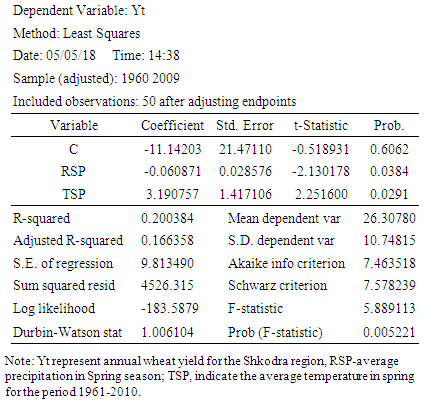 |
| |
|
From the results, the average precipitation and temperature in spring in this model were highly significant P<005 (0.038; 0.029). By looking at Prob.(F-statistic) (0.005) the model was also important which revealed the existence of collinearity.  | (1) |
According to the data from 1961-2010, changes of average temperature in spring, have caused more positive impact in wheat yield, while precipitations have had mainly negative impacts. While looking for the distributions of residuals, it resulted that JB was smaller than Hi2 (0.49< 5.99) therefore we concluded that residuals had a normal distribution. We checked also for Heteroskedasticity (white test) and it resulted that, the residual e did not have heterosis because nr*R2=LM2 1.99< 5.99 H0. Hence the variance of the residuals of the variables in the regressive were constant (homoscedastic). Additionally, in autocorrelation test, the results showed that all values fallen into the interval which confirmed there was no autocorrelation among variables. We also looked for redundant variables (excessive or omitted variable in the model) by using Reduction-Omit test. Table 2. Excessive or omitted variable in the model
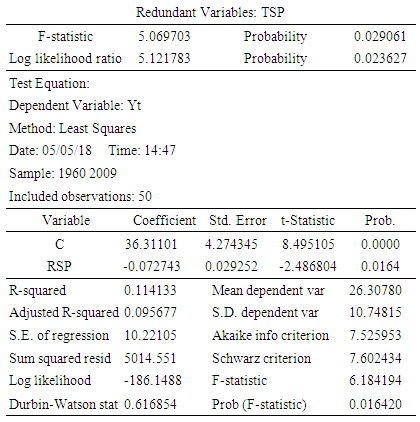 |
| |
|
The outcomes, revealed that the probability was less than 0.05 (0.02 <0.05) or Log likelihood ratio 5.12 > 3.84 (hi 20.05; 1), therefore average temperature in spring was an important variable in the model. Another model included in our analysis was the distributed-lag model in which displayed that the effect of a regressor for precipitation and temperature in spring season on wheat yield, occurs over time rather than all at once. The general form of a distributed lag model (DLM) is presented in the equation 2:  | (2) |
The results for this test are shown in the Table 3. | (3) |
The results revealed that average wheat yields for the Shkodra region were affected by the temperatures of the current year and by the temperatures of the previous year. We also used Koyck model to look for the dependency of wheat yield with climate variables. By comparing the probabilities of the coefficients with AIC of each model the equation (4), displays the best model: | (4) |
Table 3. The effects of climate variables in wheat yield over time by using distributed-lag model
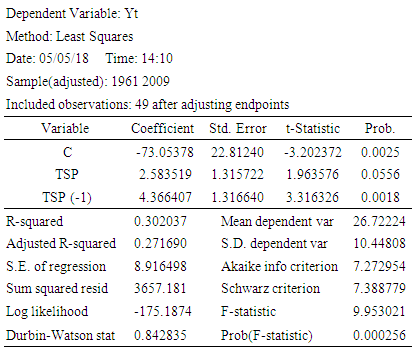 |
| |
|
Hence it resulted that wheat yield for a particular year depends on the temperatures and yields of previous year. We also tested if wheat yield was a stationary series.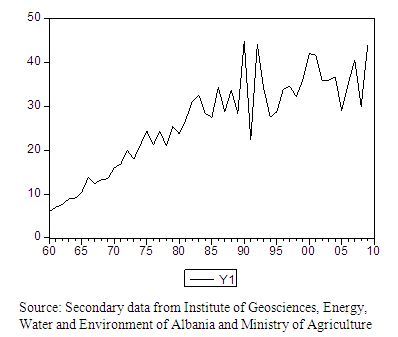 | Graph 1. Wheat yield fluctuation for the Shkodra region between 1961-2010 |
The graph.1 in general shows an increase tendency of wheat yield between 1961-2010 which make us suspected for a non-stationary series but according to correlogram test some data resulted outside the interval therefore the series was non-stationary. We also used unit root test for the intercept the ADF in absolute values was smaller than critical values for alpha 0.05 |-1.72| < |-2.92|, therefore it determined non-stationary. We also included in the model both the trend and the intercept. The results are shown in the Table 4.Table 4. Results for nonstationarity by including both intercept and trends
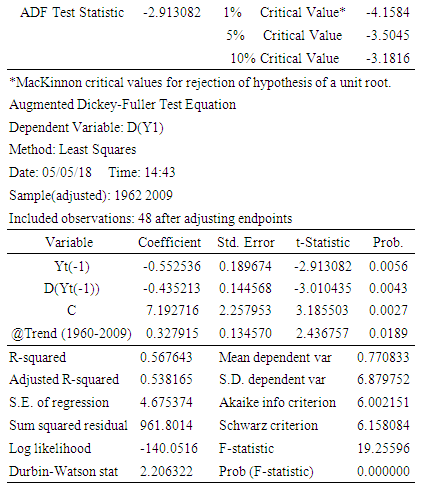 |
| |
|
By looking at the value |-2.9| < |-3.5| Hence we again conclude that we had non-stationary series. Even when we removed the trend and intercept from the model, the result showed non-stationarity series |-0.86| < |-1.94|. From the Johansen cointegration test in it resulted a cointegration only with wheat yield and precipitation in spring, while as for temperature we didn’t have a cointegration. Further-more we managed to evaluate residual correction mechanism and resulted that short-term fluctuation of temperatures and precipitation had a significant impact in wheat yield in which about 27% of variance e between actual value and the one equilibrated values of long term of wheat yield were removed or adjusted every year.  | (5) |
4. Conclusions
In this paper we concluded that temperature and precipitation were two climate variables which played an important role in crop yield throughout decades. According to many scientific studies, climate change did have direct impact in agriculture sector. Historical data for the period 1961 to 2010 showed that crops in the Shkodra region have been affected mainly to seasonal changes of temperatures and precipitation. Our findings also support the result attained from the other studies done in Albania. According to this paper we recognized that even in a local area we can obviously see changes in climate patterns which consequently had impact on wheat yield in the Shkodra region. Even though in the model were included only climate variables, based on many statistical tests, we could validate its impacts in wheat yield. The results proved that in five decades, crops were affected mostly by the seasonal changes of temperatures and precipitations. Furthermore, in this paper we concluded that precipitation from 1961-2010, have had mostly negative impacts in wheat yield, while temperature in spring have had mostly positive impacts. We also came in conclusion that wheat yield of a particular year, were depended on the conditions of yield and temperature of previous year.
ACKNOWLEDGEMENTS
This research paper was part of a Ph.D. research and was achieved by the advices and the support of my supervisor prof. Dr. Myslym Osmani. This document was produced with the financial support of the Prince Albert II of Monaco Foundation. The contents of this document are solely the liability of Ms. Ada Metaliu and under no circumstances may be considered as a reflection of the position of the Prince Albert II of Monaco Foundation and the IPCC."
References
| [1] | Ana Iglesias, Luis Garrote, Sonia Quiroga, Marta Moneo (2009). Impacts of climate change in agriculture in Europe. PESETA-Agriculture study. Universidad Politécnica de Madrid. JRC Scientific and Technical Reports. EUR 24107 EN. |
| [2] | Bruce A. McCarl (2006). US Agriculture in the climate change squeezes; Part 1. Sectoral sensitivity and vulnerability. Regents Professor of Agricultural Economics, Texas A&M University. Report to National Environment Trust. |
| [3] | David B. Lobell, Wolfram Schlenker and Justin Costa-Roberts (2011). Climate Trends and Global Crop Production Since 1980. 1204531 DOI: 10.1126/science.1204531. |
| [4] | FAO, (2008). Climate Change and Food Security. A Framework Document. Summary. Interdepartmental Working Group on Climate Change, Rome. |
| [5] | Huntingford, C., F. Lambert, J. Gash, C. Taylor and A. Challinor. (2005). Aspects of climate change prediction relevant to crop productivity. Phil. Trans Royal Soc. B 360 1999–2009. |
| [6] | IPCC, (2007): Climate Change 2007: Synthesis Report. Contribution of Working Groups I, II and III to the Fourth Assessment Report of the Intergovernmental Panel on Climate Change [Core Writing Team, Pachauri, R.K and Reisinger, A. (eds.)]. IPCC, Geneva, Switzerland, 104 pp. |
| [7] | IPCC, (2014): Summary for policymakers. In: Climate Change 2014: Impacts, Adaptation, and Vulnerability. Part A: Global and Sectoral Aspects. Contribution of Working Group II to the Fifth Assessment Report of the Intergovernmental Panel on Climate Change [Field, C.B., V.R. Barros, D.J. Dokken, K.J. Mach, M.D. Mastrandrea, T.E. Bilir, M. Chatterjee, K.L. Ebi, Y.O. Estrada, R.C. Genova, B. Girma, E.S. Kissel, A.N. Levy, S. MacCracken, P.R. Mastrandrea, and L.L. White (eds.)]. Cambridge University Press, Cambridge, United Kingdom and New York, NY, USA, pp. 1-32. |
| [8] | Ministry of Environment and the United Nations Development Program (2016). Third National Communication of the Republic of Albania under the United Nations Framework Convention on Climate Change Tirana, June 2016. |
| [9] | Ministry of Environment and the United Nations Development Program (2009). Second National Communication of The Republic of Albania under the United Nations Framework Convention on Climate Change Tirana. |
| [10] | Robert Mendelsohn, (2009). The Impact of Climate Change on Agriculture in Developing Countries. Journal of Natural Resources Policy Research, Yale University, New Haven, CT, USA, Vol. 1, No. 1, 5–19. |










 Abstract
Abstract Reference
Reference Full-Text PDF
Full-Text PDF Full-text HTML
Full-text HTML


